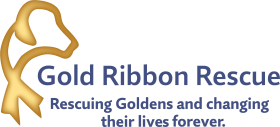 |
|
| Upcoming Events
May 17, 2014:  Need to Renew Click link to access the Gold Ribbon Rescue on Facebook Make a Become a Volunteer – lots of exciting opportunities Foster – helping a golden is rewarding Contact Sheila to 
PO Box 956 Austin, TX 78767 512 659-4653 www.grr-tx.com |
Dog Introductions: The Ins and Outs
|
May 2014
©2015-2023 Gold Ribbon Rescue
Gold Ribbon Rescue does not and shall not discriminate on the basis of race, color, religion, gender, gender expression, age, ancestry, disability, sexual orientation or military status, in any of its activities or operations.

 The integration of a new dog into the home, whether it’s a foster or a permanent situation, needs to be handled with the least amount of stress on the humans and both the resident and incoming dogs. The timeframe for introducing dogs can be an hour or minutes, a day, several days or even weeks but taking some time to integrate and introduce dogs saves time, heartache and possibly a dog’s life.
The integration of a new dog into the home, whether it’s a foster or a permanent situation, needs to be handled with the least amount of stress on the humans and both the resident and incoming dogs. The timeframe for introducing dogs can be an hour or minutes, a day, several days or even weeks but taking some time to integrate and introduce dogs saves time, heartache and possibly a dog’s life. Over the last 15 years, I’ve been blessed to have had five golden retrievers in my life. The first two were 8-week-old golden fuzz balls when they joined our family, littermates, sources of incredible joy. They also required lots of work on my part, from general puppy care through advanced obedience training, and needed plenty of exercise as they grew into adulthood.
Over the last 15 years, I’ve been blessed to have had five golden retrievers in my life. The first two were 8-week-old golden fuzz balls when they joined our family, littermates, sources of incredible joy. They also required lots of work on my part, from general puppy care through advanced obedience training, and needed plenty of exercise as they grew into adulthood. With Spring, we associate a fresh, new life: when worms begin to emerge from the earth, ladybugs land on screen doors, green buds appear, birds chirp, and flowers begin to bloom. After the long and dark hours of Winter, Spring indicates re-birth and rejuvenation.
With Spring, we associate a fresh, new life: when worms begin to emerge from the earth, ladybugs land on screen doors, green buds appear, birds chirp, and flowers begin to bloom. After the long and dark hours of Winter, Spring indicates re-birth and rejuvenation. How long have you been volunteering with GRR?
How long have you been volunteering with GRR? We adopted Bagel (Diamond) back in Oct 2013. She and Biskit and we (Bill and Evi) have been a hit since day one. Biskit is our other golden. She and Bagel are about the same age (Biskit will be 2 in June). Biskit is also small for a golden and only a bit bigger than Bagel. They are best buds since we got Bagel. Bagel loves the backyard as we have a lot of squirrels and birds, keeping the two goldens busy for hours on end. If Bagel is outside, she's chasing and stalking squirrels, sunning or chewing on a bone. The whole back of our house is large windows, reaching almost to the floor. If she's inside, Bagel is often darting back and forth from one window to another, watching squirrels outside (squirrel TV we call it).
We adopted Bagel (Diamond) back in Oct 2013. She and Biskit and we (Bill and Evi) have been a hit since day one. Biskit is our other golden. She and Bagel are about the same age (Biskit will be 2 in June). Biskit is also small for a golden and only a bit bigger than Bagel. They are best buds since we got Bagel. Bagel loves the backyard as we have a lot of squirrels and birds, keeping the two goldens busy for hours on end. If Bagel is outside, she's chasing and stalking squirrels, sunning or chewing on a bone. The whole back of our house is large windows, reaching almost to the floor. If she's inside, Bagel is often darting back and forth from one window to another, watching squirrels outside (squirrel TV we call it). 
